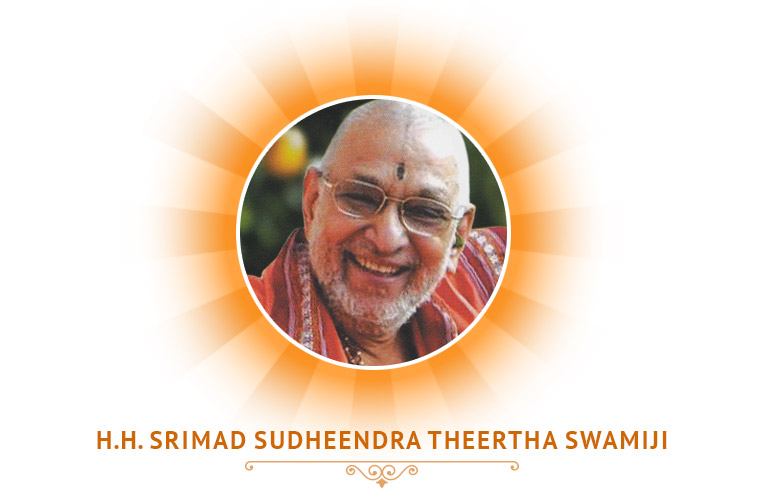Our inspiration

Madathipathi of Shree Kashi Math Samsthan, Varanasi & The Dharma Guru of the Gowda Saraswath Brahmin Community
Shrimath Sudhindra Thirtha Swamiji, the present Mathadhipati of Shree Kashi Math Samsthan, is the twentieth Swamiji in the Guru Parampara. In the Poorvashram (before being initiated into sanyasa by the previous Swamiji), he was known as Shri Sadashiva Shenoy, son of Shri Ramadas Shenoy, a trustee of Shri Venkataramana Temple in Ernakulam. He was born at Ernakulam on 31st March, 1926. He completed his Pre-University education in Maharaja’s College, Ernakulam and selected Natural Science, Physics and Chemistry as his main subjects. From an early age he had shown inclination towards a religious life. The noble traits of his character, his devotion to God, his desire to serve his fellow men, his honesty, his integrity and his love for Hindu Dharma were remarkable. When Shrimath Sukrateendra Thirtha Swamiji was camping at Ernakulam, this young boy attracted his attention. The Swamiji had the intuition to choose the right man and was divinely inspired to select this boy to be his fittest successor, later to head Shree Kashi Math Samsthan. The father’s consent was obtained for the transformation of the college student into a Sanyasi, eventually to lead a sizeable portion of Vaishnava Goud Saraswath Brahmin community in the righteous path of Vaishnava Dharma.
The Guru-Swami took him to Mulki and on Wednesday, 24th May 1944 (Karka Lagna, Jeshta Shuddha Dviteeya of Tarana Samvatsara, Shalivahana Shaka 1866) initiated him into Sanyas in the divine presence of Lord Sri Venkataramana, Sri Ugra Narasimha and Sri Bindu Madhava in Mulki (KA IN) and renamed him as SHRIMATH SUDHINDRA THIRTHA, who then severed the family connections and took to his new duties earnestly and enthusiastically and led an austere life. He felt the need of equipping himself with all the knowledge of the Dharma Shastras. He mastered Sanskrit at the Bhuvanendra Sanskrit College, Karkala. The scholarly teachers of the college were appointed to impart the necessary education in Dharma Shastras. He was camping in Shrinivasa Ashrama in the College premises. In those days he was very fond of animals. There were many petscluding&nbs;a deer and a tiger cub in Shrinivasa Ashrama.
After taking the vow of celibacy in 1944 and preserving it since then, the Swamiji strives day in and day out for the welfare and uplift of the community as a whole. Endowed with excellent grasping power, wonderful memory and extraordinary intelligence and plenty of God’s grace and Guru’s blessings, he completed hisstudy in a short time. The Brahma Sutra, The Bhagavad Gita and the Upanishads (Prasthana Traya) and other works were studied in great detail. He became a great scholar in Dwaita philosophy, as propounded by Shri Madhvacharya. He learnt the methods of worshipping God according to Agama Shastra. He travelled with the Guru to various places and picked up his duties well. He sat at the feet of the Guru and learnt the traditions of Shree KashiMath.
His Holiness had taken charge of the Samsthan in 1949 after the Mukti of his Guru Shrimath Sukrathindra Thirtha Swamiji in Kochi. He bore the loss of his Guru with courage and took over the reigns of the spiritual chariot of the followers of Shree Kashi Math Samsthan in his able hands and has been leading the chariot since then.
He traveled widely from Kanya Kumari to Badrinath, meeting his disciples, exhorting them to lead a life of morality and religion, conducting the pujas to Shri Vyasa-Raghupati with unbounded devotion and single-pointed concentration and praying at all times for the welfare of the community. Kindness, compassion, generosity and breadth of vision are the strong traits of his way of work. He visited many places of pilgrimage including Nashik, Ujjain, Kurukshetra, Mathura, Ayodhya, Prayag, Kashi, Haridwar, Rishikesh, Badri, Tirupati, Srirangam, Madurai, Palani, Kumbhakonam, Rameshwaram and Kanya Kumari.
Few Objectives of our Kashi math samsathan is given below:
1. To build up spiritual, religious, moral, educational, physical, cultural, social and economic life of the members of the Samaj.
2. To help deserving students in prosecuting their studies in Vedic religion or Shastras or in Arts, Commerce, Science and professional courses in school and colleges by giving them loans or scholarships, refundable with or without interest.
3. To provide homes for the poor and deserving children of the community, giving them free boarding at suitable centers.
4. To start, establish, construct, maintain or take over maternity homes, orphanages,relief centers etc. for helping and rehabilitating the sick for the eradication of beggary.
5. To publish and print booklets, books, pamphlets, magazines and other works on religious, social, economic or other subjects useful to the community members.
6. To renovate old temples of the community and to build or construct and manage new temples.
7. To give monetary help for the expenses of the marriages of the girls and the upanayanas of the boys of the absolutely poor members of the community and forcremation of the dead bodies and obsequies of the absolutely poor members of the community.
For more information, visit kashimath.org